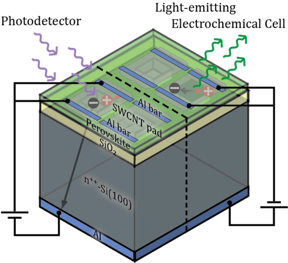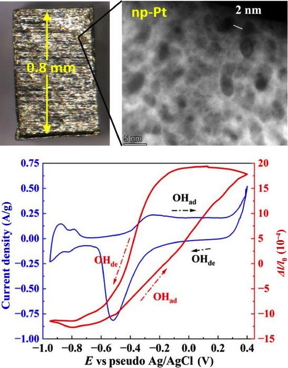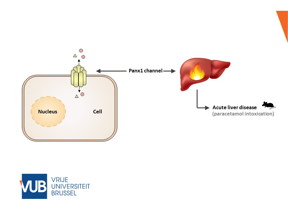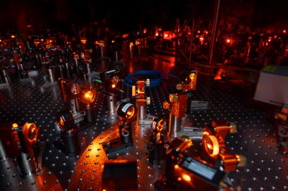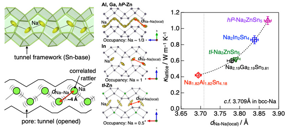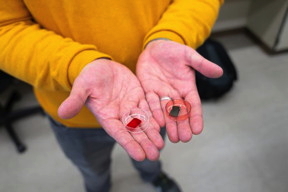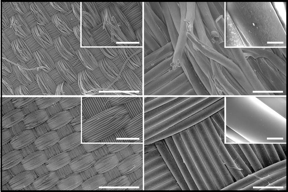Home > Press > Researchers develop artificial building blocks of life
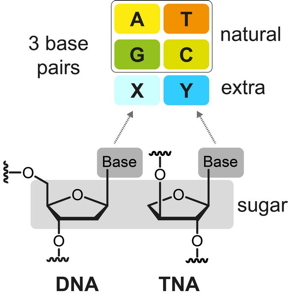 |
| Structural comparison of DNA and the artificial TNA, a Xeno nucleic acid with the natural base pairs AT and GC and an additional base pair (XY).
CREDIT |
Abstract:
The DNA carries the genetic information of all living organisms and consists of only four different building blocks, the nucleotides. Nucleotides are composed of three distinctive parts: a sugar molecule, a phosphate group and one of the four nucleobases adenine, thymine, guanine and cytosine. The nucleotides are lined up millions of times and form the DNA double helix, similar to a spiral staircase. Scientists from the UoC’s Department of Chemistry have now shown that the structure of nucleotides can be modified to a great extent in the laboratory. The researchers developed so-called threofuranosyl nucleic acid (TNA) with a new, additional base pair. These are the first steps on the way to fully artificial nucleic acids with enhanced chemical functionalities. The study ‘Expanding the Horizon of the Xeno Nucleic Acid Space: Threose Nucleic Acids with Increased Information Storage’ was published in the Journal of the American Chemical Society.
Researchers develop artificial building blocks of life
Köln, Germany | Posted on March 8th, 2024
Artificial nucleic acids differ in structure from their originals. These changes affect their stability and function. “Our threofuranosyl nucleic acid is more stable than the naturally occurring nucleic acids DNA and RNA, which brings many advantages for future therapeutic use,” said Professor Dr Stephanie Kath-Schorr. For the study, the 5-carbon sugar deoxyribose, which forms the backbone in DNA, was replaced by a 4-carbon sugar. In addition, the number of nucleobases was increased from four to six. By exchanging the sugar, the TNA is not recognized by the cell’s own degradation enzymes. This has been a problem with nucleic acid-based therapeutics, as synthetically produced RNA that is introduced into a cell is rapidly degraded and loses its effect. The introduction of TNAs into cells that remain undetected could now maintain the effect for longer. “In addition, the built-in unnatural base pair enables alternative binding options to target molecules in the cell,” added Hannah Depmeier, lead author of the study. Kath-Schorr is certain that such a function can be used in particular in the development of new aptamers, short DNA or RNA sequences, which can be used for the targeted control of cellular mechanisms. TNAs could also be used for the targeted transport of drugs to specific organs in the body (targeted drug delivery) as well as in diagnostics; they could also be useful for the recognition of viral proteins or biomarkers.
####
For more information, please click here
Contacts:
Media Contact
Anna Euteneuer
University of Cologne
Expert Contact
Stephanie Kath-Schorr
University of Cologne
@UniCologne
Copyright © University of Cologne
If you have a comment, please Contact us.
Issuers of news releases, not 7th Wave, Inc. or Nanotechnology Now, are solely responsible for the accuracy of the content.
| Related Links |
| Related News Press |
News and information
Possible Futures
![]()
Nanoscale CL thermometry with lanthanide-doped heavy-metal oxide in TEM March 8th, 2024
Nanomedicine
![]()
High-tech ‘paint’ could spare patients repeated surgeries March 8th, 2024
![]()
Superbug killer: New synthetic molecule highly effective against drug-resistant bacteria February 16th, 2024
Discoveries
![]()
What heat can tell us about battery chemistry: using the Peltier effect to study lithium-ion cells March 8th, 2024
![]()
Researchers’ approach may protect quantum computers from attacks March 8th, 2024
![]()
High-tech ‘paint’ could spare patients repeated surgeries March 8th, 2024
![]()
Nanoscale CL thermometry with lanthanide-doped heavy-metal oxide in TEM March 8th, 2024
Announcements
![]()
What heat can tell us about battery chemistry: using the Peltier effect to study lithium-ion cells March 8th, 2024
![]()
Nanoscale CL thermometry with lanthanide-doped heavy-metal oxide in TEM March 8th, 2024
Interviews/Book Reviews/Essays/Reports/Podcasts/Journals/White papers/Posters
![]()
Nanoscale CL thermometry with lanthanide-doped heavy-metal oxide in TEM March 8th, 2024
![]()
Optically trapped quantum droplets of light can bind together to form macroscopic complexes March 8th, 2024
Nanobiotechnology
![]()
High-tech ‘paint’ could spare patients repeated surgeries March 8th, 2024
![]()
Superbug killer: New synthetic molecule highly effective against drug-resistant bacteria February 16th, 2024
- SEO Powered Content & PR Distribution. Get Amplified Today.
- PlatoData.Network Vertical Generative Ai. Empower Yourself. Access Here.
- PlatoAiStream. Web3 Intelligence. Knowledge Amplified. Access Here.
- PlatoESG. Carbon, CleanTech, Energy, Environment, Solar, Waste Management. Access Here.
- PlatoHealth. Biotech and Clinical Trials Intelligence. Access Here.
- Source: http://www.nanotech-now.com/news.cgi?story_id=57463
- :has
- :is
- :not
- $UP
- 10
- 16th
- 27
- 4
- 7
- 7th
- 8th
- a
- About
- access
- accuracy
- added
- addition
- Additional
- advanced
- advantages
- affect
- against
- All
- also
- alternative
- American
- an
- and
- approach
- ARE
- artificial
- AS
- At
- author
- Backbone
- base
- battery
- BE
- been
- Better
- bind
- binding
- biomarkers
- Blocks
- body
- Brazilian
- Brings
- Building
- built-in
- by
- CAN
- cell
- Cells
- cellular
- Center
- certain
- CGI
- Changes
- chemical
- chemistry
- click
- COM
- comment
- comparison
- composed
- computers
- consists
- content
- control
- could
- credit
- del
- delivery
- Department
- Derivatives
- develop
- developed
- Development
- Diagnostics
- differ
- different
- Discovers
- distinctive
- dna
- double
- dr
- drug
- Drug Delivery
- Drugs
- effect
- Effective
- enables
- end
- enhanced
- Ether (ETH)
- exchanging
- extent
- February
- First
- first steps
- For
- form
- forms
- formulation
- four
- frameworks
- from
- fully
- function
- functionalities
- future
- genetic
- Germany
- gif
- great
- Group
- Have
- Health
- highly
- horizon
- http
- HTTPS
- if
- in
- Inc.
- increased
- inflammation
- information
- Institute
- into
- introduced
- Introduction
- involving
- ITS
- journal
- jpg
- killer
- laboratory
- lead
- Leads
- Life
- light
- lined
- links
- living
- longer
- Loses
- maintain
- many
- March
- materials
- May..
- mechanism
- mechanisms
- million
- millions
- modified
- molecule
- more
- nanotechnology
- Natural
- naturally
- net
- New
- news
- novel
- now
- number
- occurring
- of
- on
- ONE
- only
- Options
- or
- organisms
- Originals
- overall
- own
- paint
- pair
- pairs
- pandemic
- particular
- parts
- patients
- PHP
- plato
- Plato Data Intelligence
- PlatoData
- please
- Post
- posted
- press
- Press Release
- Problem
- Produced
- Professor
- protect
- protection
- Proteins
- proved
- published
- Quantum
- quantum computers
- rapidly
- receives
- recognition
- recognized
- release
- Releases
- remain
- repeated
- replaced
- research
- researchers
- responsible
- return
- RNA
- s
- Said
- Save
- scientists
- Search
- Share
- Short
- shown
- similar
- SIX
- Society
- Soft
- solely
- Space
- specific
- spiral
- Stability
- stable
- start
- Steps
- structural
- structure
- Study
- submit
- such
- sugar
- Surface
- synthetic
- synthetically
- Target
- targeted
- team
- tell
- tested
- tests
- than
- that
- The
- their
- Therapeutic
- therapeutics
- These
- they
- this
- three
- times
- to
- together
- transport
- trapped
- treatment
- undetected
- Universal
- university
- us
- use
- used
- useful
- using
- viral
- was
- Water
- Wave
- Way..
- WELL
- which
- with
- Yahoo
- you
- zephyrnet











